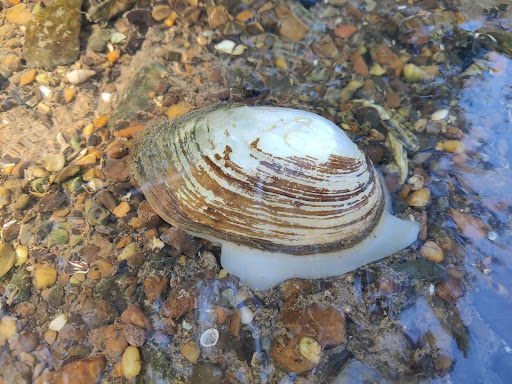Written by: Evan Banzhaf
Valentine’s Day is upon us once again, a time when many of us express the love we have for others. But we at ORF want to share a unique story of ‘self-love’ happening in our local waterways!
Down at the bottom of your nearby stream or river, you can find an extraordinary creature: the freshwater mussel. This soft-bodied invertebrate stays safely enclosed inside of its two protective shells. Unable to swim or move very far, they stick out their pseudopod, or ‘false foot,’ to partially bury or anchor themselves at the bottom of the waterway. Here in this spot, they will live out their long, solitary life, siphoning water through their body to filter out food, such as algae. Without eyes or ears, they rely on changes in light levels and water temperature to know when it’s time to breed. But wait: if they can’t move or swim, and they can’t see or hear… how do they breed?
A Freshwater Hermaphrodite
A freshwater mussel sticking out its pseudopod.
Rather than physically coming together to mate, a male mussel will simply release his sperm into the water, hoping a lucky female of his species will be located somewhere downstream of him, and intake his sperm as she’s filter feeding. It’s a complete shot in the dark, as male and female mussels will never meet. This part of the love story may not sound very romantic, but some freshwater mussels just happen to know how to spice things up…
Meet Toxoplasma Parvum, or the Lilliput. This little cutie, growing to only 1 inch in length, is actually hermaphroditic: simultaneously male and female, and capable of self-fertilization. Other hermaphroditic freshwater mussels native to the Ohio River Basin include the Paper Pondshell, the Creek Heelsplitter, and the Pondhorn. Hermaphroditism and self-fertilization can be a way for some mussel species to successfully reproduce when their population density in an area is low. When there are fewer mussels in a waterway, chances will be lower that male sperm will reach a breeding female at the right time.
Spreading Love to Save Mussels
But why are freshwater mussel populations suffering? In the past, our very own Ohio River Watershed was world renowned for its abundance and diversity of mussels. But today, some 70% of those species are extinct or under threat, making freshwater mussels one of the most imperiled groups of animals in North America. The threats to their survival include water pollution, habitat fragmentation from human-built dams, invasive species such as the zebra mussel, and overharvesting for industry in centuries past.
An older student helps younger students meet a freshwater mussel during a MIC program.
Despite the many challenges they face, here at ORF we know that one of the best ways to inspire people to help is by spreading love. That’s why two of these hermaphroditic mussel species, the Lilliput and the Paper Pondshell, are among several common Ohio River Basin species that students get to meet as part of our Mussels in the Classroom program (MIC). By participating in MIC, students take care of live freshwater mussels right in their own classroom for two weeks – and growing to love these incredibly important creatures is just inevitable! >>>>Learn more about MIC here.
Ohio River Foundation also supports healthy freshwater mussel habitats through our restoration projects. Managing native plant diversity on the land areas in our watershed improves pollution filtration from runoff, and reduces sedimentation and flash flooding that can damage critical aquatic habitats. ORF also works to remove low-head dams, reconnecting fragmented waterways to allow water, food, fish and mussel gametes to travel where they need to go for the benefit of all aquatic creatures.
You, too, can shower some love on our freshwater friends by planting native plants or advocating for more native trees and plants around your own neighborhood, school or business! Improving local waterways is a win, win, win. Shower yourself and our mussel friends with love today!


